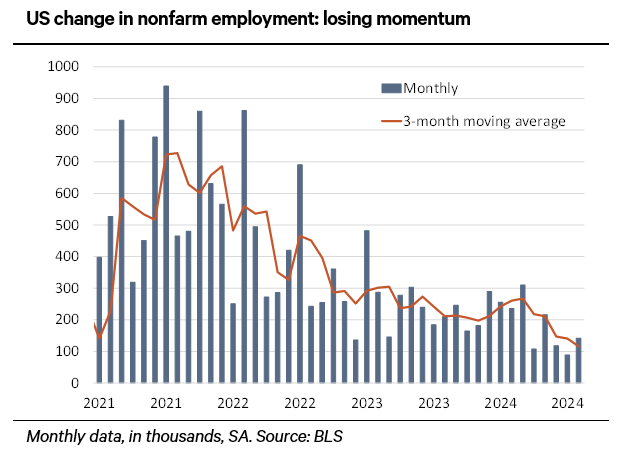Click here for full report and disclosures
â No clear case for a 50bp rate cut: The US labour market continues to lose momentum. However, the downtrend is not bad enough, in our view, to require a headline-grabbing 50bp rate cut at the Fedâs next meeting on 18 September. Instead, the modest rebound in payroll gains in August after a weak July, coupled with the slight decline in the unemployment rate and an uptick in wage inflation, suggests that the Fed can proceed more cautiously, lowering rates by 25bp at each of its remaining three meetings this year. Thereafter, the Fed could slow the pace â cutting once a quarter in H1 2025, before stopping at a 4-4.25% Fed funds band in mid-2025. Of course, the risk to our Fed call is tilted towards more aggressive Fed action.
â Labour market is slowing, but not cracking: The increase in the number of nonfarm employees of 142k in August (Bloomberg consensus: +165k) suits our view that the labour market is softening, but not collapsing. The July figure was revised downwards from 144k to 89k. Extreme weather probably played a role here. In August, the number of people on temporary layoff declined by 190k to 872k, mostly offsetting an increase in July. Given the volatility of the monthly nonfarm payrolls figure, it makes sense to look at the three-month average, which now stands at 116k (see chart). This continues a clear downward trend â see chart. While monthly employment growth has fallen well below the 2014-2023 average of 166k, it is not (yet) in recessionary territory. Despite employment cooling, the unemployment rate fell from 4.3% in July to 4.2% in August, after rising for six consecutive months.
â A gradual slowdown: Other labour market data also paint a more nuanced picture than the weak July report, which had triggered significant market turmoil last month. Admittedly, the Job Openings and Labor Turnover Survey (JOLTS) report on job openings for July was a bit of a mixed bag. On the one hand, the number of job openings dropped to a three-and-a-half year low of 7.7m in July (versus 8.1m expected). In addition, the ratio of job openings per unemployed person also fell back to 1.07 and, therefore, below its pre-COVID-19 level. On the other hand, the hiring rate as a percentage of total employment ticked back up to 3.5% in July, and the quits rate of those voluntarily leaving their jobs also rose to 2.1%. Moreover, initial jobless claims, which is one of the timeliest indicators, fell to an eight-week low of 227k (versus 230k expected) in the week ending 30 August. It also pushed the four-week moving average down to 230k â a 12-week low.
â Soft landing remains likely: Although payroll gains have fallen below the long-term average, wage growth remains solid. Average hourly earnings rose by 0.4% mom in August, taking the year-on-year rate to 3.8% â up from 3.6% in July. Going forward, the softening labour market is likely to have an impact on wages and, therefore, on consumersâ ability to spend. So far, however, the data for Q3 are still quite robust. The Atlanta Fedâs GDPNow estimate ticked up slightly this week to an annualised +2.1% rate for Q3, which is well above our call for a 1.2% gain for the current quarter. We expect the economy to expand at an annualised pace of growth of c1.2% in Q4 as well, before the effects of interest rate cuts kick in next year and the economy re-accelerates gradually towards its 2% trend rate of growth in mid-2025.
â The Fed can be the buffer: With inflation on the decline, the Fed can now focus fully on engineering a soft landing â see also US PCE: good enough for a first rate cut (30 August 2024). If the labour market and/or the overall economy were to deteriorate more sharply than we expect, the Fed would likely respond with more aggressive rate cuts â see also US labour data: the big buffer theory (6 September 2024). Todayâs data and comments by Fed Governor Christopher Waller that he is âopen-mindedâ about starting the easing cycle with a bigger rate cut than a 25bp move if the data warrant that points in this direction. So far, however, the evidence is still more in favour of a gradual approach.
Holger Schmieding
Chief Economist
holger.schmieding@berenberg.com
+44 7771 920377
Felix Schmidt
Senior Economist
+49 69 91 30 90 1167
Salomon Fiedler
Economist
+44 20 3753 3067
Andrew Wishart
Senior UK Economist
+44 20 3753 3017
Disclosures
This material is intended as commentary on political, economic or market conditions for institutional investors or market professionals only and does not constitute a financial analysis or a research report as defined by applicable regulation. See the "Disclaimers" section of this report.
The commentary included herein was produced by Joh. Berenberg, Gossler & Co. KG (Berenberg). For sales inquiries, please contact:
Phone: +44 (0)20 3207 7800
Email: berenberg.economics@berenberg.com
BERENBERG
Joh. Berenberg, Gossler & Co. KG
Neuer Jungfernstieg 20
20354 Hamburg
Germany
Registered Office: Hamburg, Germany
Local Court Hamburg HRA 42659
